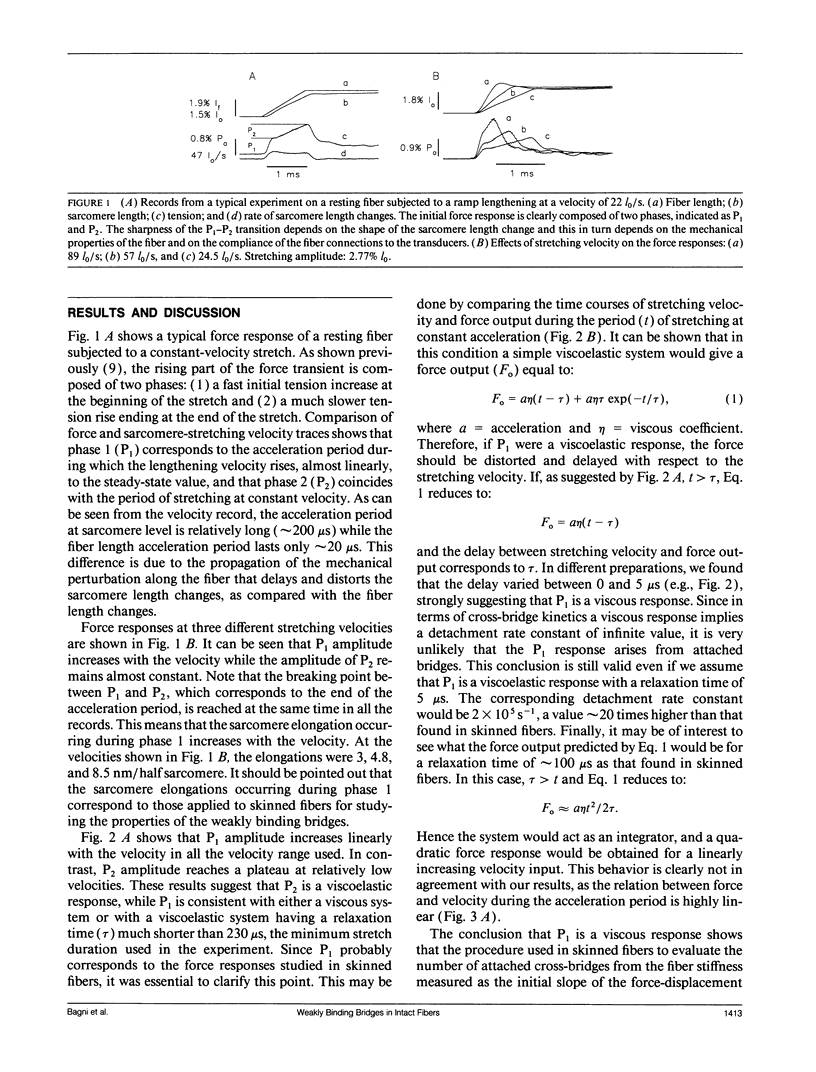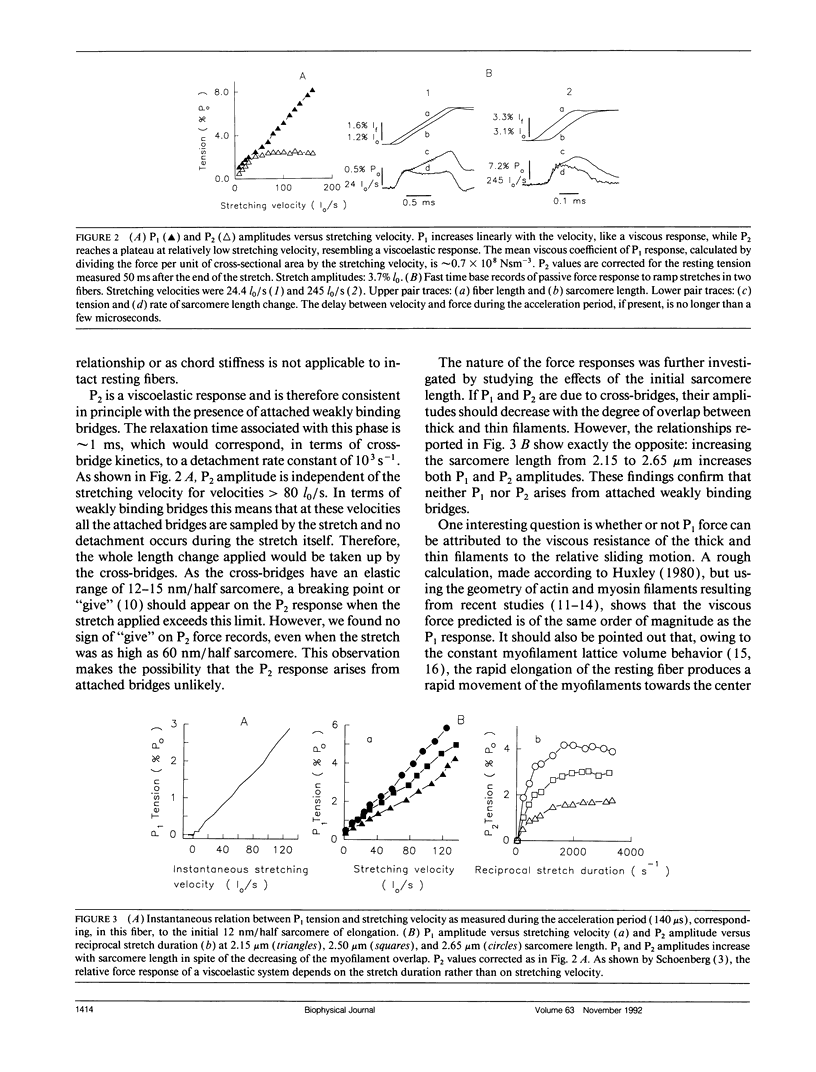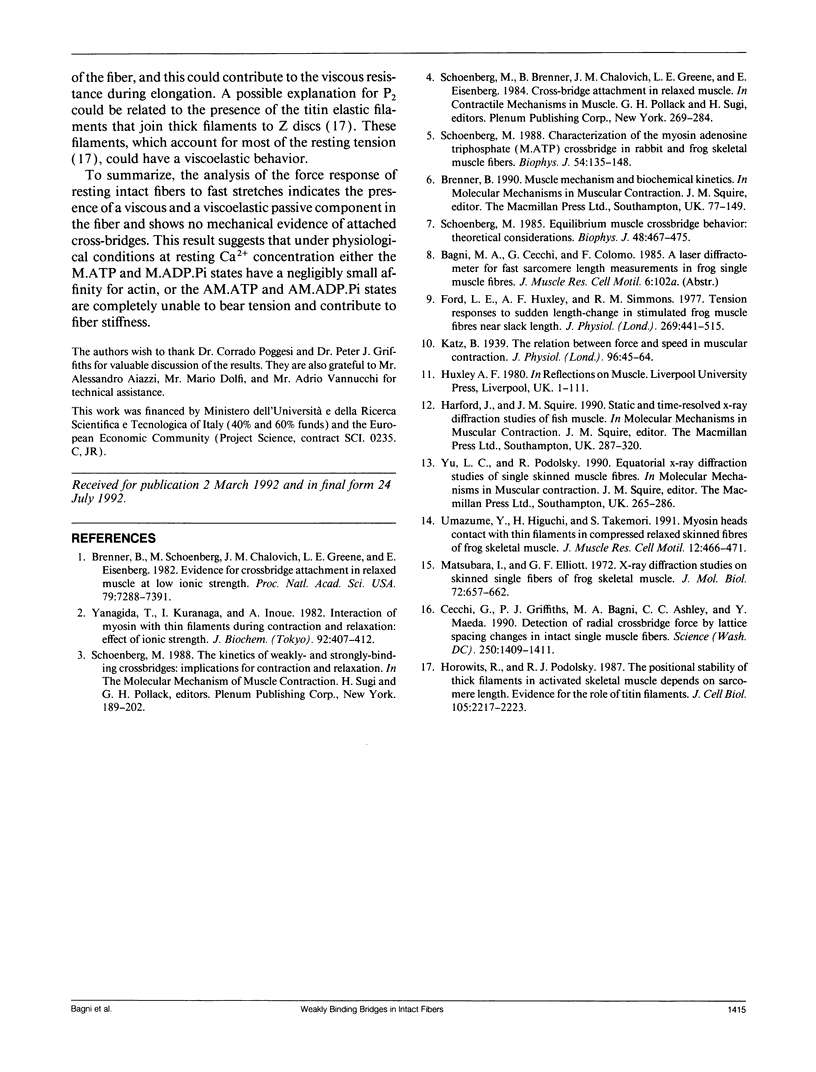Abstract
Several experimental results (Schoenberg, M. 1988. Biophys. J. 54:135-148) have shown that the force response of relaxed skinned muscle fibers to fast stretches arises from the presence of cross-bridges rapidly cycling between attached and detached states. These bridges were identified with the M.ATP<-->AM.ATP and M.ADP.Pi<-->AM.ADP.Pi states seen in solution and are commonly referred to as weakly binding bridges. In this paper we have investigated the possibility that weakly binding bridges are also present in resting intact muscle fibers. The force response to fast stretches can be accounted for by assuming the presence in the fiber of a viscous and a viscoelastic passive component arranged in parallel. None of these components has the properties previously attributed to weakly binding bridges. This shows that in intact resting fibers there is no mechanical evidence of attached cross-bridges, suggesting that, under physiological conditions, either the M.ATP or M.ADP.Pi states have a negligibly small affinity for actin or the AM.ATP and AM.ADP.Pi cross-bridge states are unable to bear tension and contribute to fiber stiffness.
Full text
PDF



Selected References
These references are in PubMed. This may not be the complete list of references from this article.
- Brenner B., Schoenberg M., Chalovich J. M., Greene L. E., Eisenberg E. Evidence for cross-bridge attachment in relaxed muscle at low ionic strength. Proc Natl Acad Sci U S A. 1982 Dec;79(23):7288–7291. doi: 10.1073/pnas.79.23.7288. [DOI] [PMC free article] [PubMed] [Google Scholar]
- Cecchi G., Bagni M. A., Griffiths P. J., Ashley C. C., Maeda Y. Detection of radial crossbridge force by lattice spacing changes in intact single muscle fibers. Science. 1990 Dec 7;250(4986):1409–1411. doi: 10.1126/science.2255911. [DOI] [PubMed] [Google Scholar]
- Ford L. E., Huxley A. F., Simmons R. M. Tension responses to sudden length change in stimulated frog muscle fibres near slack length. J Physiol. 1977 Jul;269(2):441–515. doi: 10.1113/jphysiol.1977.sp011911. [DOI] [PMC free article] [PubMed] [Google Scholar]
- Horowits R., Podolsky R. J. The positional stability of thick filaments in activated skeletal muscle depends on sarcomere length: evidence for the role of titin filaments. J Cell Biol. 1987 Nov;105(5):2217–2223. doi: 10.1083/jcb.105.5.2217. [DOI] [PMC free article] [PubMed] [Google Scholar]
- Katz B. The relation between force and speed in muscular contraction. J Physiol. 1939 Jun 14;96(1):45–64. doi: 10.1113/jphysiol.1939.sp003756. [DOI] [PMC free article] [PubMed] [Google Scholar]
- Matsubara I., Elliott G. F. X-ray diffraction studies on skinned single fibres of frog skeletal muscle. J Mol Biol. 1972 Dec 30;72(3):657–669. doi: 10.1016/0022-2836(72)90183-0. [DOI] [PubMed] [Google Scholar]
- Schoenberg M., Brenner B., Chalovich J. M., Greene L. E., Eisenberg E. Cross-bridge attachment in relaxed muscle. Adv Exp Med Biol. 1984;170:269–284. doi: 10.1007/978-1-4684-4703-3_24. [DOI] [PubMed] [Google Scholar]
- Schoenberg M. Characterization of the myosin adenosine triphosphate (M.ATP) crossbridge in rabbit and frog skeletal muscle fibers. Biophys J. 1988 Jul;54(1):135–148. doi: 10.1016/S0006-3495(88)82938-2. [DOI] [PMC free article] [PubMed] [Google Scholar]
- Schoenberg M. Equilibrium muscle cross-bridge behavior. Theoretical considerations. Biophys J. 1985 Sep;48(3):467–475. doi: 10.1016/S0006-3495(85)83802-9. [DOI] [PMC free article] [PubMed] [Google Scholar]
- Umazume Y., Higuchi H., Takemori S. Myosin heads contact with thin filaments in compressed relaxed skinned fibres of frog skeletal muscle. J Muscle Res Cell Motil. 1991 Oct;12(5):466–471. doi: 10.1007/BF01738331. [DOI] [PubMed] [Google Scholar]
- Yanagida T., Kuranaga I., Inoue A. Interaction of myosin with thin filaments during contraction and relaxation: effect of ionic strength. J Biochem. 1982 Aug;92(2):407–412. doi: 10.1093/oxfordjournals.jbchem.a133947. [DOI] [PubMed] [Google Scholar]


